|
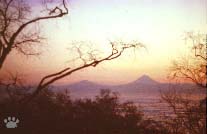
Gorely (Burnt) and Vilyuchik volcanoes, Kamchatka, Russia
Volcanic eruptions
|
Volcanic eruptions are the most spectacular natural events,
except for asteroid impacts. Some of them are so beautiful that seeing them is
one of the most justified ways to risk your life. If you are sure you are ready
to play "Russian roulette" with Nature, just read the following text
and wait for your chance to step over a fence with a warning sign on it. After
all, as a Zulu saying goes, "A man of courage dies only once; a coward dies
every day".
Warning: getting close to erupting volcanoes can
result in extremely painful injury or death.
(You can find a lot of useful stuff about visiting eruptions
and photographing them at this
site, mostly devoted to Stromboli volcano in Italy. Here
you can find recent activity updates and general info for almost all active volcanoes
in the World.)
|

Masaya volcano in Nicaragua is very active,
but it doesn't prevent thousands of parrots and
swifts from nesting in crater walls. |
The main problem with volcanic eruptions is that
they occur rarely and unpredictably, mostly in remote parts of the World.
Some of the most interesting volcanoes are in Central Africa, Antarctica, Oceania
or the Russian Far East. Many produce spectacular activity, but with very
long gaps: most of the volcanoes of the Caucasus, for
example, erupt once in 7-20 centuries; the supervolcanoes of the
Rocky Mountains wake up every 100,000-500,000 years. |

Ancient churches of
Hevsur people, Kazbek
volcano, Georgia |
| Europeans are more lucky, because they have two very
active volcanoes in Italy. Etna is famous for producing large lava flows every
few years, while Stromboli erupts every few minutes (or, sometimes, every few
hours). Both are easy to climb, although it is often windy and foggy on their
summits. Iceland is known for less regular, but very interesting eruptions. |
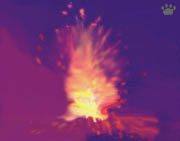
Stromboli volcano, Isole Iolie, Italy, 1993 |
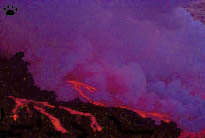
Lava entering the ocean,
Kilawea, Hawaii, 1998 |
For Americans, the most popular place to watch
volcanic activity is Kilawea Volcano, Hawaii. For decades it has produced spectacular lava flows almost non-stop. The flows from PuuOo crater often enter
the ocean just a few miles from a paved road. Updates on Kilawea activity can be found here. |
| For observing more violent activity, Volcan Arenal in Costa Rica
is a good place. It erupts every few hours, mostly at night. Climbing Arenal
is forbidden, so you have to do it late at night, or try to walk around the ranger
station through the jungle. Although night climbing is more dangerous, the tree-fern
forest on the slopes is very dense and covered with volcanic ash, so it is very
difficult to break through. A good idea is to pass the ranger station at night
and continue your climb at dawn. (2004 update: the activity has decreased a lot compared with the 1990-s, and
is not worth the climb anymore). |

Volcan Arenal,
Costa Rica, 1995 |
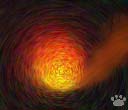
Lava ball, Arenal, 1995 |
The main source of danger on Arenal are huge (up to
25m/85' in diameter) balls of hot lava. They "drop" from the edges of
lava flows and roll down the steep slopes very fast. It's a good idea to keep
to higher places and small ridges while climbing Arenal or other volcanoes. |
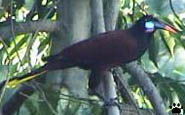 |
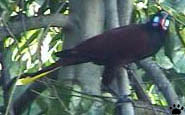 |
 |
| This Montezuma oropendola
(Gymnostinops montezuma) was mimicking the sounds of volcanic explosions.
Volcan Arenal, 2004. |
| Kamchatka Peninsula
in Russia has more than 40 active volcanoes, some of them very interesting
or unusual. The main center of activity is the Klyuchevsky Group of seven huge
volcanoes in the north-eastern part of the peninsula. Two of its members, Bezymyanny
and Shiveluch, are famous for extremely violent explosions.
Tolbachik volcano (not visible on this picture) was the site of the splendid
Great Tolbachik Fault Eruption in 1980. The Kamchatka Volcanology Institute is
located in Klyuchi village inside the Group; it is an interesting place to visit
before climbing any of the volcanoes. |
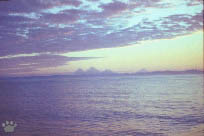
View of Klyuchevski volcanoes (Kamen',
Bezymyanny, Klyuchevskoy and Shiveluch)
from Kamchatka's Pacific Coast |
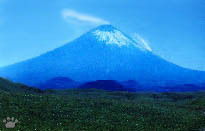
Klyuchevskoi volcano,
Kamchatka, Russia |
Klyuchevskoy Volcano, known to Russians as Klyuchevskaya
Sopka, is the highest peak in northeastern Asia. When I climbed it in 1988, it
was 4750m (15,830') high. In 1992, it was 4800m (16,000'), and keeps growing ever
since. As you have to start climbing at 15 m (50') above the sea level, this climb
is a good survival test. In the 1980-s the main danger was the rocks melting out
of glaciers in midday and rolling down. The summit crater was on top of a hill
at the bottom of an older crater, so there was almost no danger of lava blocks
falling down on a climber's head. |
| In the 1990-s, the constant activity of summit and side craters
has greatly reduced the glaciers and covered them with ash. The top hill has overgrown
the surrounding crater rim, so lava and bombs can roll all the way down to the
so-called Bombardment Tundra in the foothills. Although climbing Klyuchevskoi
becomes more and more dangerous, the award for climbers is a fantastic view of
the crater and the unbroken panorama of Kamchatka,
Pacific Ocean and the Sea of Okhotsk. |
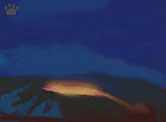
Crater of Klyuchevskoi,
Kamchatka, Russia, 1988 |

Explosion,
Klyuchevskoi, Kamchatka |
As the shape of Klyuchevskoi changes, it is more and more difficult
to find a sheltered place to spend night near the summit. Keep in mind that all
depressions around active craters may contain "pools" of carbon dioxide,
a lethal gas capable of passing through a standard gas mask (you can get a special
filter for it for such a case). Much more common around active volcanoes, geysers,
and hot springs is sulfur dioxide, but it has strong smell and almost never reaches
deadly concentrations. By the way, it's much more dangerous to become an amateur
volcanologist if you have any respiratory or heart problems. |
| Another group of Kamchatka's volcanoes, east from Kronotskoe
Lake, is famous for its geysers, dry calderas
and crater lakes. The most active here is Karymsky volcano. It erupts very often
(you can tell it by its regular shape untouched by erosion), but it is impossible
to climb during eruptions. It was almost inaccessible when I visited it in 1989,
but now it's regularly visited during helicopter tours to Geyzer Valley. |
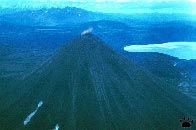
Karymsky volcano and Kronotskoe Lake,
Kamchatka, Russia |
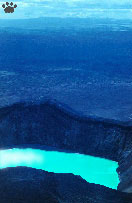
Maly Semlyachik volcano,
Kamchatka, Russia, 1988 |
Other wonders of Kronotsky Group include Krasheninnikov
Caldera with 6 craters nested in each other, beautifully shaped Kronotsky Volcano,
black tar lake on Glavny (Main) Semlyachik and sulfuric
acid lake on Maly (Lesser) Semlyachik. The latter lake changes its color every
few years: in the 1970-s it was white, in the 1980-s it turned green, and now
is reportedly blue. All these volcanoes and Uzon Caldera are easy to see from
a helicopter on a Geyzer Valley tour, but you have to arrange it with the pilots
prior to takeoff. A hike to the volcanoes and the Valley takes 2-4 weeks, is extremely
difficult due to lack of trails (there's plenty of bear trails, but they are difficult
to follow), and is not always possible due to changing restrictions (most of the
area is a part of a huge Nature reserve called Kronotsky Zapovednik). |
| Swimming in crater lakes, always check
the water first, and never get far from shore: there can be very hot springs at
the bottom, some of them periodically active. In this lake on southern Kuril Islands,
a few people have been killed by sudden explosions of boiling water from the bottom.
Giant brown bears frequently visit hot springs and lakes of Kamchatka and Kuril
Islands. |
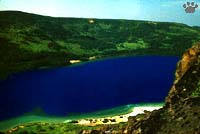
Hot Lake in Golovnin Caldera,
Kunashir I., Russia |
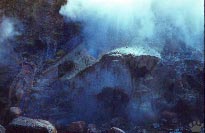
"Stove" Geyser,
Kamchatka, Russia |
Geyser Valley is by far the most famous place
on Kamchatka Peninsula. It is small compared to Yellowstone, but has higher concentration
of geysers and hot springs with more variety of weird-colored mineral deposits.
Unfortunately, most of its wonders are not close enough to the helipad and cannot
be seen on a regular one-day tour. Further upstream, there is seldom visited Valley
of Death. Due to high concentration of carbon dioxide on its floor, this valley
is sometimes full of bear and wolverine corpses. |
| The most beautiful volcanic crater I've ever seen was the main
crater of Mutnovsky volcano in southern Kamchatka. You entered it through a narrow
canyon to find yourself in an alien landscape: hills of sulfur, swamps of acid,
and lakes of boiling mud, glowing at night. Three icefalls were dropping in from
a large glacier on the crater rim. One of these icefalls was bright-blue, another
was covered with red surface moraine, and the third one was golden-yellow from
sulfur deposits. |
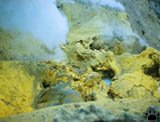
Crater floor of Mutnovsky, Kamchatka |
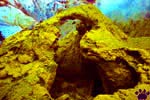
Sulfur formations, Mutnovsky crater |
Active fumaroles in the crater constantly ejected huge
volumes of boiling water, steam and sulfuric oxide. Some rare and beautiful minerals
crystallized around fumarole openings. Molten sulfur formed giant columns, arches
and mushroom-shaped hills in the crater. They used to grow and fall apart rapidly,
so every few days the crater bottom changed its appearance. Unfortunately, this
unearthly beauty was mostly destroyed by 1997-2002 eruptions. |
| Gorely (Burnt) volcano is another member of Mutnovsky Group.
It is a long rocky ridge with eleven craters. Five of them have glaciers inside,
and two have lakes. Approximately once in a decade, one of the craters erupts.
But the eruptions of Gorely are usually brief, from a few hours to two weeks.
A hike along the ridge of the volcano is a good way to see different types of
craters in one day. |

Crater #10 of Gorely, Kamchatka |
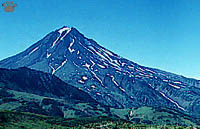
Vilyuchik Volcano, Kamchatka, Russia |
The high plateau between Mutnovsky, Gorely
and Vilyuchik volcanoes is locally known as "The Museum of Natural Disasters".
Earthquakes, eruptions, avalanches, rockslides, snow- and duststorms are so common
here that the entire area has never been inhabited by people. Neighboring fjords
are periodically hit by tsunamis and flash floods. The plateau is now crossed
by a dirt road leading to a geothermal power plant at Mutnovsky. |
| Avacha is the only volcano on Kamchatka easily accessible in
winter: it is just above the main city of the peninsula. For decades, hundreds
of people climbed it to see the beautiful golden Vesuvius-style crater. Its 1991
eruption fell on a weekend, and I just happened to have some spare money, so I
took the next flight from Moscow. A flight across Russia takes 10 hours, so by
the time I climbed Avacha, the lava was already cooling down. |
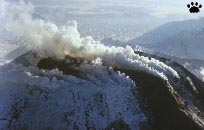
Eruption of Avacha Volcano,
Kamchatka, Russia, 1991 |
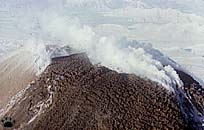
Lava overflowing the crater rim,
Avacha volcano, Russia, 1991 |
The most impressive part of this eruption was not its visual
effects, but its sound: you needed some ear protection a few miles from the crater,
and at the summit it was far above pain level. I learned two things on this eruption:
first, always take earplugs; second, never approach an eruption site on plastic
skis. They'd be eaten away by the invisible layer of abrasive ash on the snow.
Wooden skis would last much longer. |
| Walking around volcanic craters, try to avoid the areas covered
with fresh lava shrapnel and volcanic bombs. I didn't know it on my first eruption
site, at Ebeko Volcano on Kuril Islands, and almost got killed by a sudden explosion.
I had two hard hats, and I put them on while trying to escape red-hot rocks raining
down. Both hats were broken by the time I ran away from the blast zone. Cauliflower-like
clouds above the crater may look safe at first, but later they can collapse and
turn into a rain of stones or a boiling pyroclastic flow spreading around at hundreds
miles per hour. |
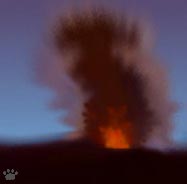
Eruption of Ebeko volcano,
Paramushir Island, Russia |

Hakalau Nature Reserve,
Mauna Loa, Hawaii |
Some eruptions last for years, even centuries, but others are
over within hours or, sometimes, seconds. If the eruption is over, or there is
a pause in activity just when you get there, don't be upset. Seeing a good eruption
is a prize for which five-six attempts is not too much. Volcanic areas are always
beautiful; some of the World's best Nature reserves are on volcanic slopes. Just
forget about the money you've spent, relax and enjoy the scenery. |
| Probably the most beautiful feature of volcanoes between eruptions
is crater lakes. You can see all possible colors: dark blue (such as in Golovnin
Caldera on Kunashir, Kuril Islands), turquoise (Maly Semlyachik),
green (Poas and Irazu in Costa Rica), white (Ebeko), yellow (Cutoff Head in Ussuriland),
black (Pyaktusan on China/Korea border), red
(a scarlet lake had existed a few decades ago in Anak Krakatau), bright-golden
(there is one in an unnamed crater on Kunashir), silver (Mono
Lake in California) or purely transparent (Crater Lake, Lake
Taal in the Philippines). |

Crater Lake, Oregon, USA |
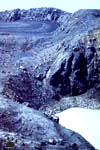
White Crater Lake, Ebeco,
Paramushir, Kuril Isls. |

Tar Lake, Glavny
Semlyahik, Kamchatka |
|

Purple Lake, Golovnin,
Kunashir, Kurile Isles. |

Rainbow Lake, Lassen, California |
|
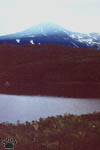
Black Crater Lake, Ebeco,
Paramushir, Kuril Isls. |

Fire Cave, Kuhi-Malik,
Tajikistan |
Visiting some places requires the same preparations and precautions
as seeing volcanic eruptions, although those places are not related to volcanism.
Good examples are mud volcanoes of Caspian Sea coasts,
or the famous fire caves of Anzob Gorge in Tajikistan. These caves lead to burning
coal layers deep underground. The coal has been burning for thousands of years
(the place was mentioned by Herodotus), so cave walls are decorated with unique
mineral deposits. But to enter them you need all kinds of protective equipment:
the temperature inside can be high enough to burn paper. |
| Bad weather can be a serious problem during
eruptions. Volcanoes are often high, isolated mountains, and they seem to cause
cloud formation around their peaks, even when it is clear elsewhere. An eruption
itself, of course, can decrease visibility even further. During a trip to the
Philippines, I've spent two days on Volcan Mayon, which was supposed to erupt.
But the mountain remained hidden into clouds, so I couldn't see it, and didn't
even know if it was erupting or not. Finally, on the third day, I got a few seconds
of relatively unobstructed view of the summit, with a smoke column rising from
the crater. The actual eruption didn't occur until a few months later, and was,
reportedly, very spectacular, with lava fountains up to 300 m (1000') high. |
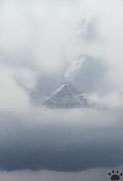
Eruption of Volcan Mayon,
Luzon, Philippines, 2001. |
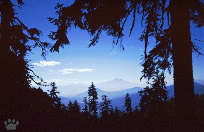
Saint Helens Volcano,
Washington, USA |
Currently I am in a good position for an eruption-chaser: Hawaii, Mexico, the Lesser Antiles and the Cascades are only a few hundred dollars away. Eruptions occur rarely in North America,
but they can be very spectacular. The main problem is access closures, as authorities
in this country always try to take care of your safety for you even if you don't
want them to. So, prepare for night hiking and long climbs! |
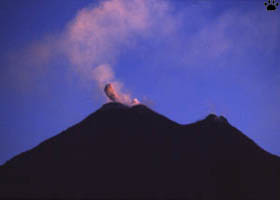
Volcan Arenal, 2004.
Part 2. Saint Helens, 2004
Home
|

